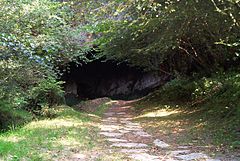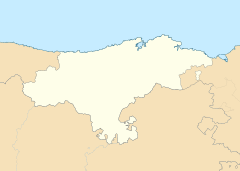
Cave paintings are a type of parietal art, found on the wall or ceilings of caves. The term usually implies prehistoric origin, but cave paintings can also be of recent production: In the Gabarnmung cave of northern Australia, the oldest paintings certainly predate 28,000 years ago, while the most recent ones were made less than a century ago.

The Cave of Altamira is a cave complex, located near the historic town of Santillana del Mar in Cantabria, Spain. It is renowned for prehistoric parietal cave art featuring charcoal drawings and polychrome paintings of contemporary local fauna and human hands. The earliest paintings were applied during the Upper Paleolithic, around 36,000 years ago. The site was discovered in 1868 by Modesto Cubillas and subsequently studied by Marcelino Sanz de Sautuola.

Matienzo is the name of a village and a karst depression some 25 km southeast of Santander in Ruesga municipality, Cantabria, northern Spain. The limestone around Matienzo is riddled with caves which have been extensively explored over the last 50 years by Spanish and British cavers. The total length of cave passage explored, as of December 2016, is 377 km.
Archaeoacoustics is the use of acoustical study as a methodological approach within the field of archaeology. Archaeoacoustics examines the acoustics of archaeological sites and artifacts. It is an interdisciplinary field that includes archaeology, ethnomusicology, acoustics and digital modelling, and is part of the wider field of music archaeology, with a particular interest in prehistoric music. Since many cultures explored through archaeology were focused on the oral and therefore the aural, researchers believe that studying the sonic nature of archaeological sites and artifacts may reveal new information on the civilizations scrutinized.

Cueva del Milodón Natural Monument is a Natural Monument located in the Chilean Patagonia, 24 km (15 mi) northwest of Puerto Natales and 270 km (168 mi) north of Punta Arenas.

The Asón-Agüera comarca is a historical region of Cantabria, Spain. It is located in the upper courses of the Asón and Agüera rivers, near the border with Vizcaya in the Basque Country. The comarca encompasses the basin of the Asón river and its tributaries such as the Gándara.

Valle de Abdalajís is a town and municipality in the province of Málaga, part of the autonomous community of Andalucía in southern Spain. It is located in the comarca of Antequera. The municipality is situated approximately 50 kilometres from the provincial capital of Málaga. It has a population of approximately 3,000 residents. The natives are called Vallesteros.

Entrambasaguas is a small municipality located in the autonomous community of Cantabria, Spain, 25 km south of the Bay of Santander. It is moderately mountainous, and the origin of the Aguanaz River, which once drove 23 watermills and merges with the Miera River. Limestone caves with Paleolithic rock art and burial sites from the Bronze Age exist. Iron was mined here from prehistoric times, used in the Royal Artillery Factory of La Cavada, which supplied the Armada, and eventually brought some wealth during the Renaissance. First mentioned in 1210, this rural area of Green Spain consists of six towns an area of 43.2 square km, totaling about 5,000 inhabitants as of 2015, having nearly doubled since 2005.

The Cueva del Castillo, or Cave of the Castle, is an archaeological site within the complex of the Caves of Monte Castillo, in Puente Viesgo, Cantabria, Spain.
Eberhard Fjord is an arm of Seno Ultima Esperanza in the Patagonian region of Chile. This surface water body was named after Hermann Eberhard, the first European to explore this region. Eberhard used the fjord to find the Cueva del Milodón, where he discovered remains of the extinct Giant sloth; archaeological recovery of evidence of prehistoric man was also found at this cave complex. Geologically this fjord is within the Magallanes Basin.

Cueva Fell is a natural cave and archaeological site in southern Patagonia. Cueva Fell is in proximity to the Pali Aike Crater, another significant archaeological site. Cueva Fell combined with the nearby Pali Aike site have been submitted to UNESCO as a possible World Heritage Site.

The Cantabrian caves' unique location make them an ideal place to observe the settlements of early humans thousands of years ago. The magnificent art in the caves includes figures of various animals of the time such as bison, horses, goats, deer, cattle, hands and other paintings. Archaeologists have found remains of animals such as bears, the remains of arrows and other material indicating a human presence; these artifacts are now found mostly in the Regional Museum of Prehistory and Archaeology of Cantabria.

Cueva de la Candelaria is an archaeological site located in the Coahuila State (México). It is a cave that was used as cemetery by nomad visitors. Early site research was made in 1953 and there was a later season in 1954. As a result of these investigations, many materials were recovered and are kept by Instituto Nacional de Antropología e Historia (INAH).
Cueva de la Ranchería is an archaeological site located south of Ciudad Madera, in the Sirupa Canyon region, northwest of the Mexican state of Chihuahua.
Cueva de la Momia is an archaeological site located in the region of Ciudad Madera, in the Sirupa Canyon region, northwest of the Mexican state of Chihuahua. It is located at the foot of a very high cliff on the ravine of the Arroyo del Venado, shortly before it joins the Rio Chico; in the vicinity of the Huápoca Canyon, is a series of caves where a number of mummies were found.

Huápoca is an archaeological site located 36 kilometers west of Ciudad Madera, in the Huápoca Canyon region, northwest of the Mexican state of Chihuahua.

The Painted cave is an archaeological museum and park in the town of Galdar, located the northwest of Grand Canary in the Canary Islands, Spain. This centre is part of the Spanish Ministry of Culture, Historic Heritage and Museums of the town council of Grand Canary.

The La Garma cave complex is a parietal art-bearing paleoanthropological cave system in Cantabria, Spain. It is located just north of the village of Omoño, part of the municipality of Ribamontán al Monte. The cave complex is noted for one of the best preserved floors from the Paleolithic containing more than 4,000 fossils and more than 500 graphical units. It is part of the Cave of Altamira and Paleolithic Cave Art of Northern Spain World Heritage Site.

Encarnación Cabré Herreros was a Spanish archaeologist.


















